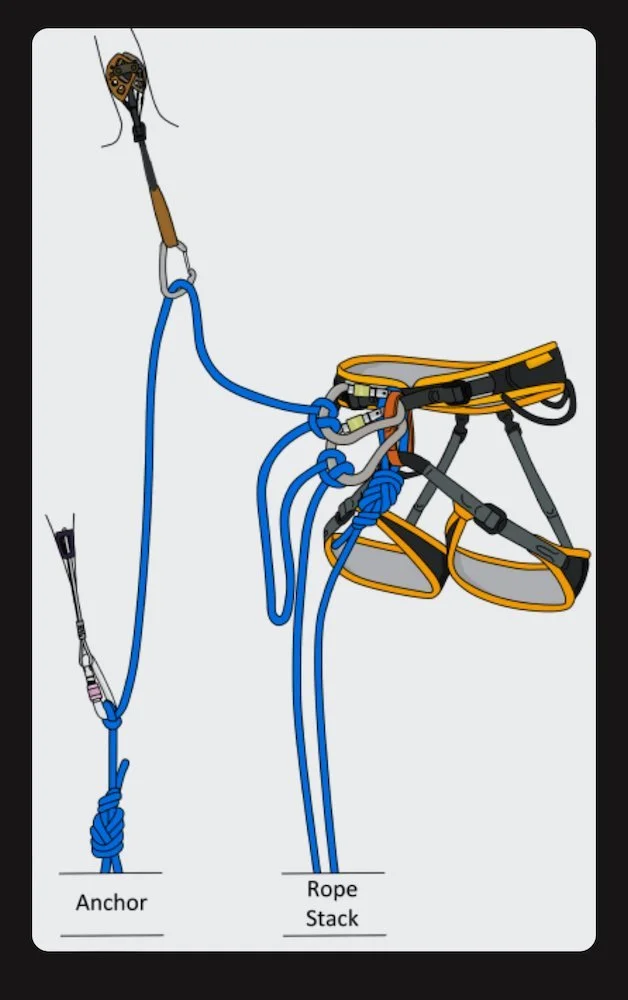Climbing on a chopped rope - lead rope soloing
Note - This post discusses techniques and methods used in vertical rope work. If you do them wrong, you could die. Always practice vertical rope techniques under the supervision of a qualified instructor, and ideally in a progression: from flat ground, to staircase, to vertical close to the ground before you ever try them in a real climbing situation.
image shared with permission: https://www.vdiffclimbing.com/rope-solo/
Yo! Lead rope soloing is a VERY advanced technique and far beyond the scope of this article to teach you how to do safely. I’m only introducing this technique if you have to use it in the following unfortunate and unlikely situation.
You’re on a committing route and have the following misfortune:
Due to whatever random act of the goddess, your lead rope gets a severe cut or is damaged by rockfall.
To make it even more challenging, the cut is close to the center of the rope. (If the damage is near one end, you may be able to cut the rope and continue climbing on whatever you have left. You may have to get creative with belay anchors.)
Due to the route, your position on it, or whatever, you decide that it’s better to continue leading UP rather than to rappel DOWN. (In many cases, heading down might be the better choice. There are several clever ways to rappel when you can avoid passing that pesky knot entirely. Here's an article on that.)
If you cut out the damaged part of the rope and tie the two pieces together, the knot won't go through protection if you climb and belay in the normal manner.
So, the crucial question: how do you continue to lead?
An option is lead rope soloing. When lead rope soloing, the rope doesn’t pass through the placed gear like in normal leading.
This lets you climb with a knot in the middle of your rope, schweeeet!
But, it's gonna be awkward, slow and kind of scary, so that's not so schweeeet!
Lead rope soloing is normally the realm of socially inept big wall climbers, who can't find a partner for their week+ vertical camping trip on El Capitan, or big wall speed climbers, who do what’s called “short fixing” to efficiently keep climbing while their partner is cleaning the last pitch.
There are many possible ways to rig a lead rope solo. Here’s one.
The basic sequence:
One end of the rope is tied to an anchor that can take an upward pull. Bolts are ideal.
Stack the rope carefully so it can feed smoothly from both ends.
The leader feeds out some rope from the anchor so they can make a few moves, ties a clove hitch and clips it to their belay loop with a locker.
If you want to be extra cautious, you could tie it back up clove on a second locking carabiner, as shown in the diagram.
Leader climbs up, places gear, clips the rope like normal. When they come tight onto the clove hitch, they feed more rope through it, and keep on going.
Use a tether, PAS, quickdraw, sling whatever to clip in directly to gear, and use two hands to adjust your clove. (Forget ethics or your previous idea of an onsight, you're trying to get up the route and save your ass. It’s aid climbing, you can do anything you want!)
The leader can take the rope with them in a rope bag or backpack, or haul it up directly off the belay. Taking it with you is maybe more hassle, but it can prevent the rope from getting stuck below you.
The leader can tie in to the other end of the rope, or they can let it hang. In the diagram above they’re tied in.
The partner below them at the belay does not have much to do other than try to make sure the rope feeds out smoothly.
Once at the top of the pitch, the leader will not be able to belay the second normally. The second is going to have to ascend the fixed rope and clean the gear as they go, just like when aid climbing. If the second has a progress capture pulley like a Micro Traxion, they can attach this to the rope and use it as a self-belay. When the second climbs up to the knot, they can tie into the rope past the knot, and be put back on a proper belay if they want.
Note that this is a very advanced technique, and not something you should be doing on a regular basis unless you are a big wall expert! However, it is an option in the bottom of your toolbox if you ever find yourself in this position, so keep it in mind.


